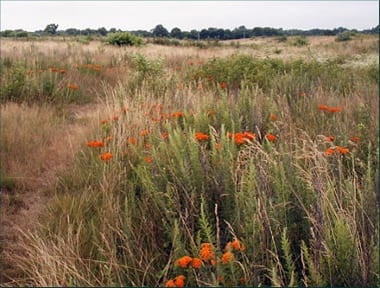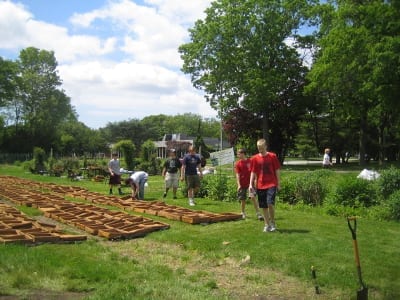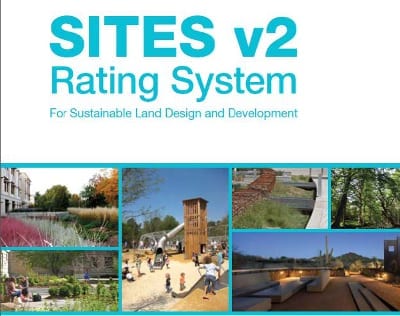Lisa Cowan, PLA, ASLA
Although the Sustainable Sites Initiative (SITESTM) Rating System may first appear to be just another green rating system, ELA members should know that SITES can be a valuable resource for ecological site restoration projects (even if you are not going for certification). For those who have not familiarized themselves with SITES already, it is a program that offers a systematic approach to define, develop, enhance and restore landscapes with the goal of improving ecosystem services, community benefits and economic performance. From that perspective, here are 7 things that you should know about the recently released SITES v2 rating system for your next project.

The SITES Pilot Project at Hempstead Plains Interpretive Center, New York. Photo courtesy of Friends of Hempstead Plains and CeCe Haydock, Landscape Architect.
- An e-version of SITES v2 is free! Although there are several SITES bundles, each of which can cost between $75 and $135 to purchase, the (Bundle #1 Rating System + Scorecard) can be downloaded as a pdf, for free. They do request your contact information, etc., but in exchange you get the 121-page bundle which outlines the process for Sustainable Land Design and Development. Get it.
- SITES v2 is a model for sustainable site practices that can be shared with clients. A printed or e-version of SITES v2 can be shared with your clients so they can appreciate that, similar to LEED, there is a comprehensive system to develop and rate high performance landscapes. Because SITES v2 combines the typical design/development process with construction, maintenance, and performance practices – it gives you the opportunity to address all aspects of responsible restoration with your clients upfront, as they should be, and not after construction. The list of Sections (or “processes”) includes Understanding Site Context, Pre-Design Assessment + Planning, Site Design for Water, Soil + Vegetation, Materials, Human Health + Well-Being, Construction, Operations + Maintenance, and Performance Monitoring.
- SITES v2 provides helpful and realistic considerations for embarking on the complex process of ecological restoration. For instance, under “Section 2 – Use an integrative design process” you will find more details about process under the following headings:
- Form an integrated design team.
- Develop a collaborative communication process.
- Identify project sustainability principles and performance goals
- Incorporate the sustainability principles and performance goals into a program Plan.
- Identify stakeholders and site user groups.
- Plan for construction oversight
- Develop a strategy for preparing a site maintenance plan.
- The free e-version of Sites v2 provides Recommended Strategies under each Pre-Requisite and Credit. Although you can, and should, tap into SITES v2 for sustainable sites development and land management strategies for all of your projects, if the focus is on restoration, you will have to dig a bit deeper. For instance, at the end of Section 4: Site Design – Soil and Vegetation, you will find:Recommended strategies: When selecting a soil restoration strategy, consider the design, site use, and future site maintenance expectation. Potential strategies are:
- Adding mature, stable compost to unscreened soil
- Many un-screened and un-amended soils will drain adequately
- Amending with other earth materials to modify a soil gradation/texture and organic matter content.”

Salvaged “woody debris” and loam from site earthwork in Easton, Maine that were put through a grinder and reapplied to stabilize and revegetate a steep cut slope. Photo courtesy Studioverde.
- SITES v2 provides tools for staying on track. The SITES v2 Scorecard (an Excel file) which is included in the Bundle#1 free version provides a quick checklist for thinking about and keeping track of the comprehensive approach that is important to the process of ecological restoration.
- SITES v2 addresses the terminology pitfall. SITES provides a Glossary with standardized definitions and terminology that can help unite the ecological restoration community as it communicates concepts and practices internally and externally. For instance:
Vegetation and Soil Protection Zones (VSPZs): are areas identified during the pre-design phase that will be protected from all disturbances throughout the construction process to prevent damage to vegetation, soil structure, and function.
- SITES v2 includes many examples of successful projects. The Sustainable Sites Initiative publishes detailed project reviews of Certified Sites and includes projects of different contexts, sizes, and uses. The reviews are an excellent resource for inspiration, methodologies, and images that you can use in communicating visually with your clients and user groups. It helps to know that others have made the commitment and been successful in their restoration efforts. These Certified Sites might just provide the inspiration that could tip the balance toward responsible site restoration.

Eagle Scouts fill native grass green roof biotrays for the Hempstead Plains Interpretive Center SITES Pilot Project. Photo courtesy of Friends of Hempstead Plains and CeCe Haydock, Landscape Architect.
For the record, all of the information outlined in this review is based on the free e-version or is available to be downloaded for free from the Sustainable Sites Initiative website. Use it for large and small projects, rating system or reference. In any case, it is an excellent resource for ecologically-minded site practitioners!
About the Author
Lisa Cowan, PLA is Principal at Studioverde – a collaborative of landscape architects and practitioners in the fields of resource economics, ecology, horticulture and public art, working together to create high performance landscapes. She has expertise in ecology-based planning, design, low impact construction and land management and was the lead landscape architect on over thirty successful wetland and riparian creation and restoration projects. Lisa is a co-chair of the American Society of Landscape Architect’s Sustainable Design and Development (SDD) Professional Practice group and is the editor for the SDD blog for The Field. Lisa has also been active in public outreach and education on the Sustainable Sites Initiative rating system (SITES) since 2009.



